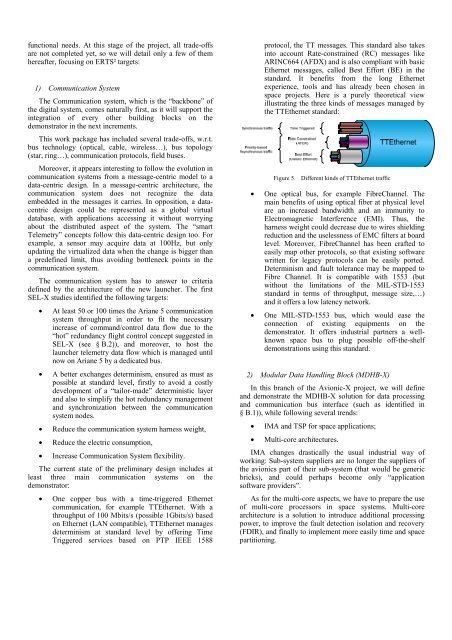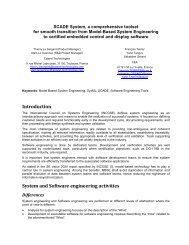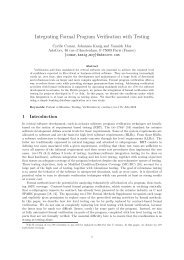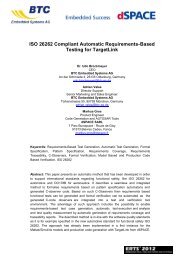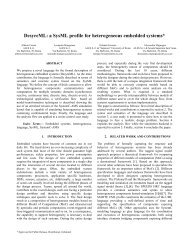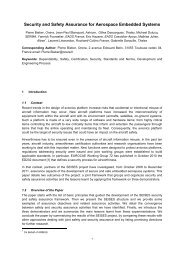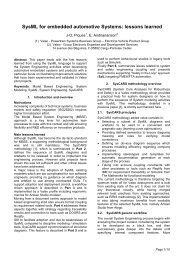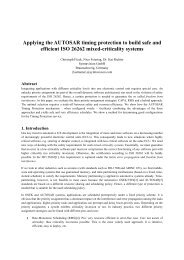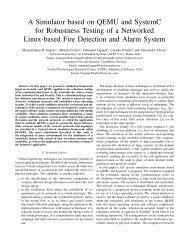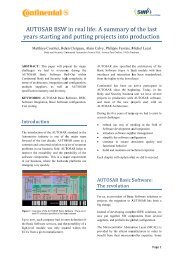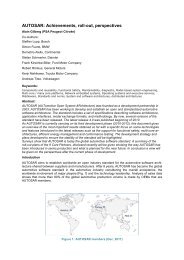Avionic-X: A demonstrator for the Next Generation Launcher Avionics
Avionic-X: A demonstrator for the Next Generation Launcher Avionics
Avionic-X: A demonstrator for the Next Generation Launcher Avionics
Create successful ePaper yourself
Turn your PDF publications into a flip-book with our unique Google optimized e-Paper software.
functional needs. At this stage of <strong>the</strong> project, all trade-offsare not completed yet, so we will detail only a few of <strong>the</strong>mhereafter, focusing on ERTS² targets:1) Communication SystemThe Communication system, which is <strong>the</strong> “backbone” of<strong>the</strong> digital system, comes naturally first, as it will support <strong>the</strong>integration of every o<strong>the</strong>r building blocks on <strong>the</strong><strong>demonstrator</strong> in <strong>the</strong> next increments.This work package has included several trade-offs, w.r.t.bus technology (optical, cable, wireless…), bus topology(star, ring…), communication protocols, field buses.Moreover, it appears interesting to follow <strong>the</strong> evolution incommunication systems from a message-centric model to adata-centric design. In a message-centric architecture, <strong>the</strong>communication system does not recognize <strong>the</strong> dataembedded in <strong>the</strong> messages it carries. In opposition, a datacentricdesign could be represented as a global virtualdatabase, with applications accessing it without worryingabout <strong>the</strong> distributed aspect of <strong>the</strong> system. The “smartTelemetry” concepts follow this data-centric design too. Forexample, a sensor may acquire data at 100Hz, but onlyupdating <strong>the</strong> virtualized data when <strong>the</strong> change is bigger thana predefined limit, thus avoiding bottleneck points in <strong>the</strong>communication system.The communication system has to answer to criteriadefined by <strong>the</strong> architecture of <strong>the</strong> new launcher. The firstSEL-X studies identified <strong>the</strong> following targets:• At least 50 or 100 times <strong>the</strong> Ariane 5 communicationsystem throughput in order to fit <strong>the</strong> necessaryincrease of command/control data flow due to <strong>the</strong>“hot” redundancy flight control concept suggested inSEL-X (see § B.2)), and moreover, to host <strong>the</strong>launcher telemetry data flow which is managed untilnow on Ariane 5 by a dedicated bus.• A better exchanges determinism, ensured as must aspossible at standard level, firstly to avoid a costlydevelopment of a “tailor-made” deterministic layerand also to simplify <strong>the</strong> hot redundancy managementand synchronization between <strong>the</strong> communicationsystem nodes.• Reduce <strong>the</strong> communication system harness weight,• Reduce <strong>the</strong> electric consumption,• Increase Communication System flexibility.The current state of <strong>the</strong> preliminary design includes atleast three main communication systems on <strong>the</strong><strong>demonstrator</strong>:• One copper bus with a time-triggered E<strong>the</strong>rnetcommunication, <strong>for</strong> example TTE<strong>the</strong>rnet. With athroughput of 100 Mbits/s (possible 1Gbits/s) basedon E<strong>the</strong>rnet (LAN compatible), TTE<strong>the</strong>rnet managesdeterminism at standard level by offering TimeTriggered services based on PTP IEEE 1588protocol, <strong>the</strong> TT messages. This standard also takesinto account Rate-constrained (RC) messages likeARINC664 (AFDX) and is also compliant with basicE<strong>the</strong>rnet messages, called Best Ef<strong>for</strong>t (BE) in <strong>the</strong>standard. It benefits from <strong>the</strong> long E<strong>the</strong>rnetexperience, tools and has already been chosen inspace projects. Here is a purely <strong>the</strong>oretical viewillustrating <strong>the</strong> three kinds of messages managed by<strong>the</strong> TTE<strong>the</strong>rnet standard:Figure 5. Different kinds of TTE<strong>the</strong>rnet traffic• One optical bus, <strong>for</strong> example FibreChannel. Themain benefits of using optical fiber at physical levelare an increased bandwidth and an immunity toElectromagnetic Interference (EMI). Thus, <strong>the</strong>harness weight could decrease due to wires shieldingreduction and <strong>the</strong> uselessness of EMC filters at boardlevel. Moreover, FibreChannel has been crafted toeasily map o<strong>the</strong>r protocols, so that existing softwarewritten <strong>for</strong> legacy protocols can be easily ported.Determinism and fault tolerance may be mapped toFibre Channel. It is compatible with 1553 (butwithout <strong>the</strong> limitations of <strong>the</strong> MIL-STD-1553standard in terms of throughput, message size,…)and it offers a low latency network.• One MIL-STD-1553 bus, which would ease <strong>the</strong>connection of existing equipments on <strong>the</strong><strong>demonstrator</strong>. It offers industrial partners a wellknownspace bus to plug possible off-<strong>the</strong>-shelfdemonstrations using this standard.2) Modular Data Handling Block (MDHB-X)In this branch of <strong>the</strong> <strong>Avionic</strong>-X project, we will defineand demonstrate <strong>the</strong> MDHB-X solution <strong>for</strong> data processingand communication bus interface (such as identified in§ B.1)), while following several trends:• IMA and TSP <strong>for</strong> space applications;• Multi-core architectures.IMA changes drastically <strong>the</strong> usual industrial way ofworking: Sub-system suppliers are no longer <strong>the</strong> suppliers of<strong>the</strong> avionics part of <strong>the</strong>ir sub-system (that would be genericbricks), and could perhaps become only “applicationsoftware providers”.As <strong>for</strong> <strong>the</strong> multi-core aspects, we have to prepare <strong>the</strong> useof multi-core processors in space systems. Multi-corearchitecture is a solution to introduce additional processingpower, to improve <strong>the</strong> fault detection isolation and recovery(FDIR), and finally to implement more easily time and spacepartitioning.


